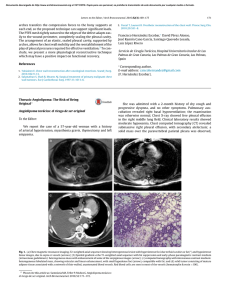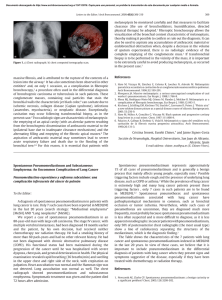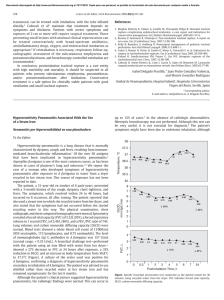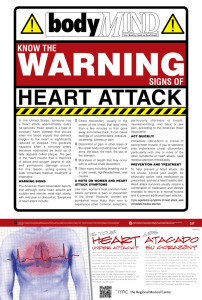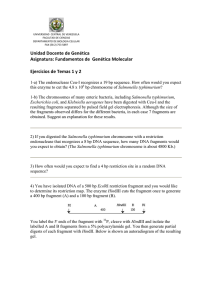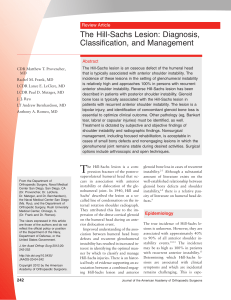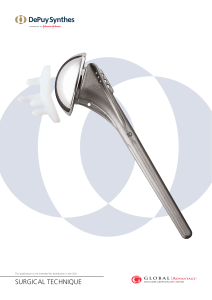Fracture-dislocation of the shoulder with intrapulmonary
Anuncio
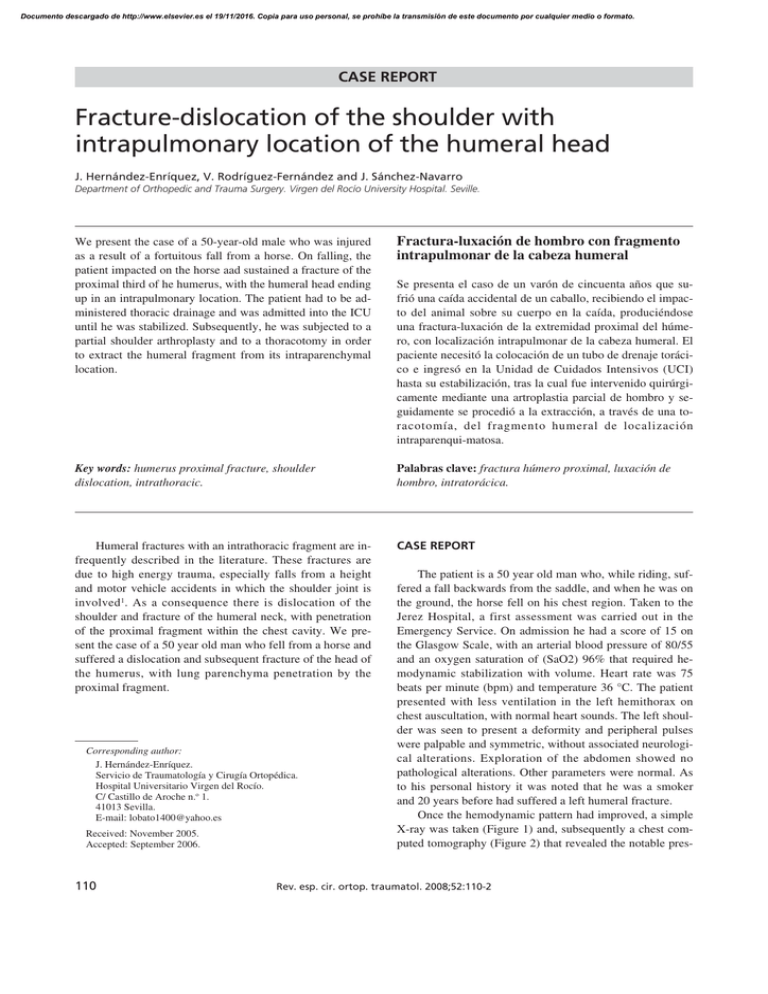
Documento descargado de http://www.elsevier.es el 19/11/2016. Copia para uso personal, se prohíbe la transmisión de este documento por cualquier medio o formato. CASE REPORT Fracture-dislocation of the shoulder with intrapulmonary location of the humeral head J. Hernández-Enríquez, V. Rodríguez-Fernández and J. Sánchez-Navarro Department of Orthopedic and Trauma Surgery. Virgen del Rocío University Hospital. Seville. We present the case of a 50-year-old male who was injured as a result of a fortuitous fall from a horse. On falling, the patient impacted on the horse aad sustained a fracture of the proximal third of he humerus, with the humeral head ending up in an intrapulmonary location. The patient had to be administered thoracic drainage and was admitted into the ICU until he was stabilized. Subsequently, he was subjected to a partial shoulder arthroplasty and to a thoracotomy in order to extract the humeral fragment from its intraparenchymal location. Fractura-luxación de hombro con fragmento intrapulmonar de la cabeza humeral Key words: humerus proximal fracture, shoulder dislocation, intrathoracic. Palabras clave: fractura húmero proximal, luxación de hombro, intratorácica. Humeral fractures with an intrathoracic fragment are infrequently described in the literature. These fractures are due to high energy trauma, especially falls from a height and motor vehicle accidents in which the shoulder joint is involved1. As a consequence there is dislocation of the shoulder and fracture of the humeral neck, with penetration of the proximal fragment within the chest cavity. We present the case of a 50 year old man who fell from a horse and suffered a dislocation and subsequent fracture of the head of the humerus, with lung parenchyma penetration by the proximal fragment. CASE REPORT Corresponding author: J. Hernández-Enríquez. Servicio de Traumatología y Cirugía Ortopédica. Hospital Universitario Virgen del Rocío. C/ Castillo de Aroche n.o 1. 41013 Sevilla. E-mail: [email protected] Received: November 2005. Accepted: September 2006. 110 Se presenta el caso de un varón de cincuenta años que sufrió una caída accidental de un caballo, recibiendo el impacto del animal sobre su cuerpo en la caída, produciéndose una fractura-luxación de la extremidad proximal del húmero, con localización intrapulmonar de la cabeza humeral. El paciente necesitó la colocación de un tubo de drenaje torácico e ingresó en la Unidad de Cuidados Intensivos (UCI) hasta su estabilización, tras la cual fue intervenido quirúrgicamente mediante una artroplastia parcial de hombro y seguidamente se procedió a la extracción, a través de una toracotomía, del fragmento humeral de localización intraparenqui-matosa. The patient is a 50 year old man who, while riding, suffered a fall backwards from the saddle, and when he was on the ground, the horse fell on his chest region. Taken to the Jerez Hospital, a first assessment was carried out in the Emergency Service. On admission he had a score of 15 on the Glasgow Scale, with an arterial blood pressure of 80/55 and an oxygen saturation of (SaO2) 96% that required hemodynamic stabilization with volume. Heart rate was 75 beats per minute (bpm) and temperature 36 °C. The patient presented with less ventilation in the left hemithorax on chest auscultation, with normal heart sounds. The left shoulder was seen to present a deformity and peripheral pulses were palpable and symmetric, without associated neurological alterations. Exploration of the abdomen showed no pathological alterations. Other parameters were normal. As to his personal history it was noted that he was a smoker and 20 years before had suffered a left humeral fracture. Once the hemodynamic pattern had improved, a simple X-ray was taken (Figure 1) and, subsequently a chest computed tomography (Figure 2) that revealed the notable pres- Rev. esp. cir. ortop. traumatol. 2008;52:110-2 Documento descargado de http://www.elsevier.es el 19/11/2016. Copia para uso personal, se prohíbe la transmisión de este documento por cualquier medio o formato. Hernández-Enríquez J et al. Fracture-dislocation of the shoulder with intrapulmonary location of the humeral head ence, due to its extension, of a subcutaneous enphysema on the anterolateral chest wall and the left upper limb that reached up to the elbow, as well as a fracture of the first 4 ribs on the left side of the chest. Moreover, it could be seen that there was a fracture of the head of the left humerus; the proximal fragment of the fracture was in the chest cavity adjacent to the base of the lung, where it was also possible to observe a small laminar pneumothorax, atelectasia and effusion, possibly of hemorrhagic origin. The patient remained hemodynamically stable throughout, with no respiratory involvement, or neurological alterations. The patient was moved to our center for a new assessment by the Trauma and Chest Surgery Service and was admitted to the ICU until his situation became stable. During his stay in the ICU, the patient evolved favorably, and was stable and eupneic at all times. During the first 24 hours 650 cc of blood were extracted through a chest drainage tube, and 350 cc subsequently. A transfusion of two packs of packed red blood cells was necessary due to a fall in hemoglobin to 7g /dl A week after the accident, the patient was taken to the Operating Room to undergo surgery by a Trauma and Chest Surgery team. The patient was placed in a semi-seated supine position with general anesthesia and a segmental orotracheal tube. The left shoulder was approached through the Neer route. During exploration fragments of the greater and lesser tuberosity and a fractured surgical neck of the humerus were seen, with absence of the proximal fragment. The rotator cuff was repaired by ligamentoplasty and a cemented hemiarthroplasy of the shoulder was inserted (Mansat prosthesis). Subsequently the patient was placed on his left side and a lateral thoracotomy was carried out over the sixth rib. After collapsing the left lung, a few remnants of blood were extracted and the humeral fragment was located in the posterior apical segment of the upper left lobe of the lung (Figure. 3). This fragment was removed, the bed in the lung parenchyma cleaned and, subsequently, sutured. Hemosthasis was checked, chest drainage tubes were left in place and the patient was once more taken to the ICU for follow-up. DISCUSSION Figure 1. Anteroposterior chest X-ray showing the hemothorax and the cephalic fragment of the humerus in the left hemithorax. Intrathoracic fractures and dislocations of the humeral head are an infrequent condition, and only 9 cases are described in the literature1-10. They are due to high energy trauma, related to falls from a height or accidents involving motor vehicles. The usual mechanism of injury is abduction with external rotation at high speeds that causes dislocation of the humerus, followed by continuous abduction that causes fracture, pushing the humeral head through the Figure 2. Chest CT-scan showing the fragment of the humerus located inside the pulmonary parenchyma. Figure 3. Thoracic approach through the left sixth intercostal space; the fragment of the humeral head can be seen sticking out of the pulmonary parenchyma. Rev. esp. cir. ortop. traumatol. 2008;52:110-2 111 Documento descargado de http://www.elsevier.es el 19/11/2016. Copia para uso personal, se prohíbe la transmisión de este documento por cualquier medio o formato. Hernández-Enríquez J et al. Fracture-dislocation of the shoulder with intrapulmonary location of the humeral head teosynthesis, we chose to perform a hemiarthroplasty and extraction of the humeral fragment; osteosynthesis was not considered viable after a week’s evolution; it was also decided to extract the humeral head from inside the chest in view of possible respiratory and hemodynamic complications. REFERENCES Figure 4. Anteroposterior chest x-ray carried out 3 months after discharge. ribcage, into the chest1. Given the rarity of this type of injury, there is no protocol to follow. In the literature 3 indirect signs are proposed to detect this type of lesion2: a) a rigid upper limb in abduction and apparently suffering shortening, b) an increase of the intercostal space at the level the humeral head seen in chest x-rays and c) a pleural silhouette surrounding the humeral head. We have not found any case in the literature that describes the presence of the fractured humeral head within the pulmonary parenchyma. Of the different hypothesis to explain such a noteworthy injury, in our opinion, the most likely one is that the left shoulder suffered dislocation when the rider fell off the horse, and subsequently, when the horse fell on the rider’s chest, the head of the humerus impacted on the first 4 ribs causing a comminuted fracture of the humeral head, with the proximal fragment penetrating the chest wall into the interior of the left pulmonary parenchyma. In spite of the fact that the age and the physical condition of the patient could have led to the performance of os- 112 1. Harman BD, Miller NG, Probe RA. Intrathoracic humeral head fracture-dislocation. J Orthop Trauma. 2004;18:112-5. 2. Eberson CP, Ng T, Green A. Contralateral intrathoracic displacement of the humeral head: a case report. J Bone Joint Surg Am. 2000;82A:105-8. 3. Simpson NS, Schwappach JR, Toby EB. Fracture-dislocation of the humerus with intrathoracic displacement of the humeral head. J Bone Joint Surg Am. 1998;80A:889-91. 4. Kaar TK, Rice JJ, Mullan GB. Fracture-dislocation of the shoulder with intrathoracic displacement of the humeral head. Injury. 1995;26:638-9. 5. Al-KaarM, García J, Khan HG. Intrathoracic dislocation fracture of the head of the humerus. J Radiol. 1998;79:57-9. 6. Brogdon BG, Crotty JM, MacFeely L. Intrathoracic fracturedislocation of the humerus. Skeletal Radiol. 1995;24:383-5. 7. Ulrich C, Helbing G, Wordsdorfer O. Intrathoracic dislocation of the head of the humerus. Langenbecks Arch Chir. 1986;367:197-202. 8. Hardscastle PH, Fisher TR. Intrathoracic displacement of the humeral head with fracture of the surgical neck. Injury. 1981;12:313-5. 9. Patel MR, Pardee ML, Singerman RC. Intrathoracic dislocation of the head of the humerus. J Bone Joint Surg Am. 1963;45A:1712-4. 10. Glessner JR Jr. Intrathoracic dislocation of the humeral head. J Bone Joint Surg Am. 1961;43A:428-30. Conflict of interests The authors have declared that they have no conflict of interests. Rev. esp. cir. ortop. traumatol. 2008;52:110-2
